A Beginners Guide to Choosing the Best Router Bits
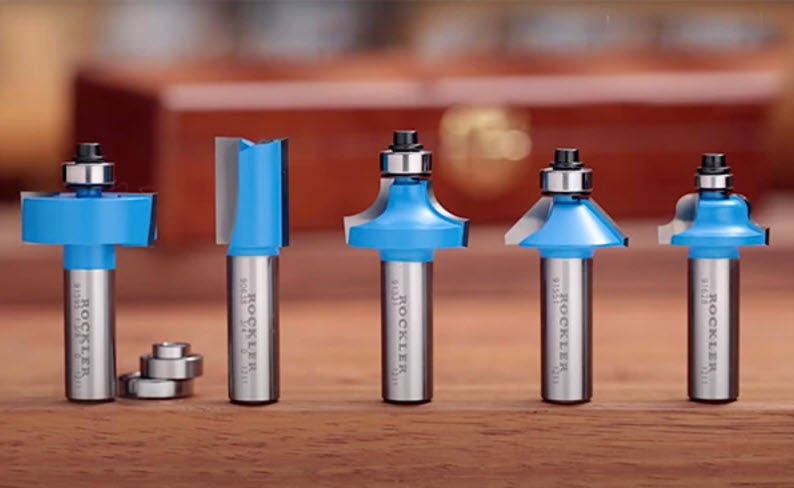
What are the first router bits you should purchase to use with your router? The router is one of the most useful and versatile woodworking tools in any shop. Of course it's not much good without router bits. And if you're new to routing, the hundreds of options can be confusing. How do you choose? Here's what you need to know to choose the best router bits for your woodworking projects.
You don’t need drawers full of different router bit profiles to get most projects done. Instead, buy different router bit profiles only as you need them. The most commonly used router bit profiles for most woodworkers include straight or spiral bits, roundover bits, cove bits, 45° chamfer bits, rabbeting bits with various sizes of bearings and flush-trim and pattern bits. Quality router bits last a long time, and choosing carefully will help you explore your router’s rich potential affordably.
VIDEO: The Best Router Bits for a Beginning Woodworking
In this video the most common types of router bits are explained for the beginning woodworker. The Rockler router bits highlighted in this video include: Straight, Rabbeting, Round Over, Flush Trim, Roman Ogee, Chamfer, and Undersized Plywood Bits.
Top 5 Router Bit Profile Categories
To make it easier to understand the vast selection of router bits, they are typically grouped into five main categories based on their applications. Here’s what you need to know:
Straight Router Bits
Straight Router Bits are a workshop staple, these bits make cuts straight into a material to form a groove or dado (a groove across the wood grain) or to hollow out an area for a mortise or inlay. They’re available in various diameters and lengths, offering flexibility to match the needs of your project.
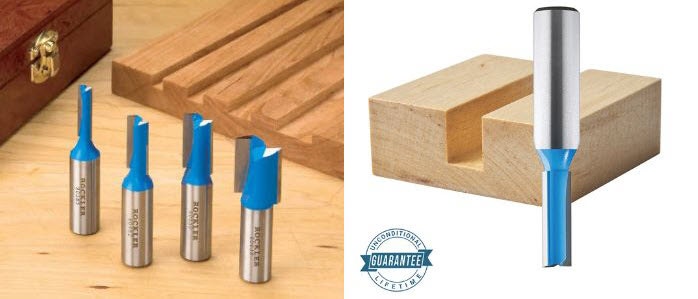
Flush Trim Router Bits
As the name suggests, flush trim router bits are used to trim the edge of one material flush with the edge of another – for example, trimming a veneered surface flush with a substrate or using a pattern to create multiple identical pieces. These router bits are also used to cut out pattern templates. They usually are guided by a pilot bearing that’s the same diameter as the cutter. The bearing may be at the top, bottom or top and bottom of the bit
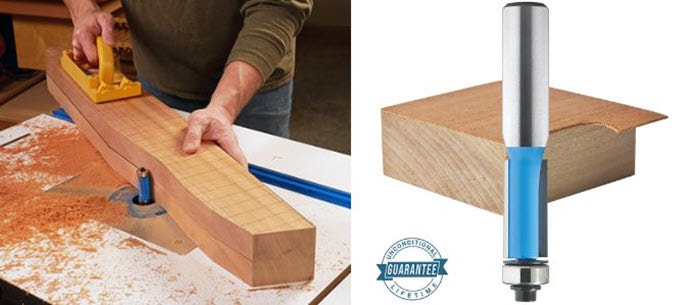
Edge Forming Router Bits
Edge-forming router bits are essential tools for adding decorative profiles to the edges of woodwork, enhancing both the aesthetic appeal and functionality of a project. These bits come in various shapes and sizes, such as round-over, chamfer, ogee, and beading, each designed to create distinct edge styles. Woodworkers commonly use edge-forming bits to add smooth curves, angled edges, or intricate designs to tabletops, shelves, cabinets, and picture frames. Beyond aesthetics, these bits can also improve comfort and safety by softening sharp edges. Versatile and easy to use, edge-forming router bits are a must-have for anyone looking to elevate the craftsmanship of their woodworking projects.

Joinery Router Bits
Joinery Router Bits form the mating profiles that make a woodworking joint. Joinery bits include Rabbeting Router Bits that are guided by a spinning pilot bearing at the tip, these router bits are designed specifically to cut a rabbet (shoulder) in the edge of a workpiece often used to join pieces. They can be purchased in a set that includes bearings of different diameters, allowing a single bit to produce rabbets of different sizes. They also include Rail-and-Stile Router Bits which are used to form the corner joints on frame and panel doors.
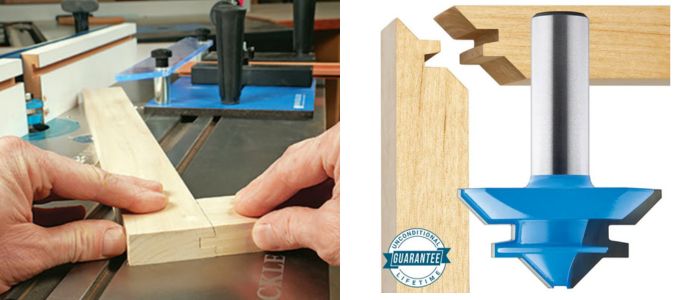
Specialty Bits
Specialty Router Bits are dedicated to specific tasks. For example, sign making router bits are designed to be used with signmaker's template kits, such as the Rockler Interlock Signmaker's Template Kits. Other examples include; raised panel bits, which shape the edges of a door panel to fit into the corresponding slot in the frame’s stiles and rails: and dish carving bits, which hollow out the inside of a bowl. Some of these bits are small and are intended for use in a handheld router, but many of these bits are somewhat large and can be used safely only in a router table
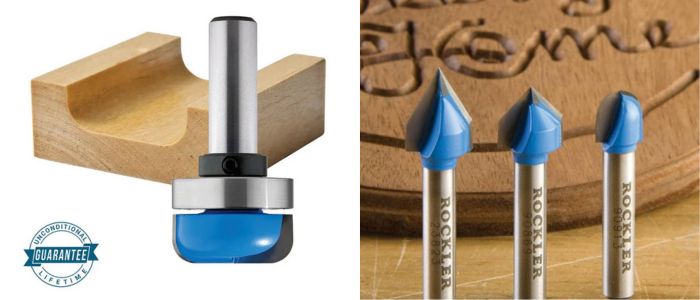
Router Bit Shanks
The router bit shank is the solid, cylindrical part of a router bit. It's the part of the bit that goes into the collet of the router. There are two common sizes of router bit shanks: 1/4" and 1/2". Many routers come with interchangeable 1/4" and 1/2" collets so that either size bit can be used, but some accept only 1/4"-dia. shank bits. Whenever possible, use bits with 1/2"-dia. shank bits. They provide better stability with less vibration, and they typically produce a smoother cut and have longer cutter life. Except for very small and very large profiles, router bits typically are available in both shank diameters.
Router Bit Cutting Edges
Most router bits have cutting edges made from high-speed steel (HSS) or carbide tips fused to the bit. Most of the profile bits will have carbide cutters, which are harder than steel and will hold an edge longer – 10 to 25 times longer – but also are more brittle. So while carbide-tipped bits are preferable, you must handle and store them carefully to avoid chipping the cutters.
Signs of Router Bit Quality
While you can't assess some factors by eye – such as the hardness and quality of the carbide or the bit’s overall balance, there are things you can look for. High-quality router bits have carbide cutters that have been sharpened to a fine edge and that are thick enough to allow for multiple regrindings. The brazing that joins the carbide tip to the bit will appear even. And high-quality bits will incorporate a design that minimizes the risk of workpiece kickback. These anti-kickback bits have more body mass, and their enlarged bodies prevent the bits from biting too deeply and catching on the material. The greater body mass also helps to dissipate heat and keep the bits sharp longer.
Price can be an indicator of quality. The old saw applies: In general, you get what you pay for. Here at Rockler, we offer our own line of router bits designed for the serious woodworker. Rockler router bits are made with high-quality ISO K10 and K20 carbide and are sharpened with 600-800 diamond abrasives. They also are precision-balanced and geometrically designed for superior chip ejection.
Important Questions And Considerations
1. Are you buying with a specific project in mind? Or are you just trying to assemble a starter set?
2. Are you likely to use the router bit occasionally, or will it get a workout every day?
3. How much do you have or want to spend?
Will You Be Mounting Your Router Or Making Handheld Cuts?
Some bits can be safely operated only in a table-mounted router with a variable-speed feature. So, for example, if you want to make a cabinet with frame-and-panel construction, you’ll need to get or build a router table before you can safely use the stile-and-rail bits and panel-raising bits required for such a project.
Just Starting Out? Consider A Router Bit Set
If you’re assembling a starter set, consider buying a couple of straight bits (maybe 1/4", 1/2" and 3/4"); a few round-over bits (1/8" and 1/4"); a rabbeting bit with interchangeable bearings of different sizes; a 45º chamfer bit; and an ogee bit. Rockler sells router bit sets that may also be good options depending on your project.
Router bits are the unsung heroes of woodworking, offering endless possibilities to shape, trim, and enhance your projects with precision and flair. Whether you're crafting furniture, cabinetry, or decorative accents, choosing the right router bit can make all the difference in achieving professional results. From edge-forming profiles to specialized joinery bits, these tools empower woodworkers to push creative boundaries while maintaining accuracy and efficiency. So, whether you're a seasoned pro or just starting out, investing in quality router bits is an investment in your craft. Grab your router, experiment with different bits, and watch your woodworking projects transform!
Keep the inspiration coming!
Subscribe to our newsletter for more woodworking tips and tricks




